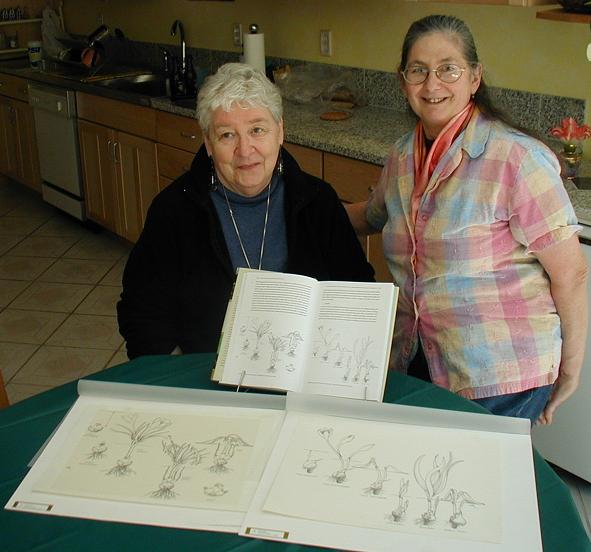
Just as happened last year, again in mid-April I had a small group of botanical artists from New Jersey and Pennsylvania come to BelleWood Gardens to sketch. Last year it rained, this year the weather was glorious - a clear, bright, sunny day with comfortable temperatures. After various and sundry cars found their way up my driveway we began with a stroll through the garden as I pointed out what's in flower: a diversity of daffodils from bold, bright yellow 'Dutch Master' (stand-in for 'King Alfred') to dainty white 'Dove Wings' and sweet 'Jenny', cyclamineus cultivars with gently swept back petals. 'Jenny' has white petals and opens with a yellow trumpet that over three days fades to cream, which gives the planting a pleasingly varied look as fresh, newly opened flowers and those of more maturity display this subtle variation. Lots of soft mauve Corydalis solida, a small charmer with ferny foliage and a small spike of dainty flowers. Happily spreading around the woodland garden, I think it looks best where paired up in front of Lenten roses, Helleborus ×orientalis, with flowers of a similar color, more so than those with pale pink or white flowers. Other hellebores flowering wonderfully well include pristine white Christmas rose, Helleborus niger, with evergreen foliage, dainty pale-green flowered Helleborus viride, and the taller bear's foot hellebore, Helleborus foetidus, with clustered small bell-like apple-green flowers. I have two treasured cultivars of corydalis from Seneca Hill Perennials, a mail-order source for unusual perennials. One is pristine white 'Snowstorm', this year with two flower spikes and the other is soft pink 'Blushing Girl', with four. Lungworts, Pulmonaria cultivars with silver-spotted leaves and an assortment of flower colors: pink buds opening to blue, others of a pale pink, another with a touch of blue in it for a cooler red than other near-by flowers - an unfortunate clashing combination, and white, are happily seeding about in both beds and the paths (seemingly a favorite site for many different plants.)
After the garden tour lunch was had, al fresco on the Forest Deck overlooking the intermittent drainage creek that runs through the garden, happily purling and babbling as it went over the rocks in good spate after the No-Name storm that flooded through the area a couple of weeks ago, early in April. That was really quite something: only a little water in our basement, but Frenchtown got really inundated. The Delaware River rose to within 12 inches of the Frenchtown - Uhlerstown bridge deck. On the Pennsylvania side it looked like the flooding of the Nile Delta - just silt and mud all over the place, mud even on top of the guard rail by the side of the road. And the Frenchtown Post Office got flooded, ruined their boiler in the basement, and they won't re-open until May. there's a trailer outside the building and they're selling stamps - cash or check only, no credit cards, and they cannot sell money orders. No idea where exactly our mail is being processed, but it is being delivered. Neither rain, nor snow - nor floods, apparently.
The ladies then dispersed throughout the garden, each finding a pleasing place to sit and sketch away the afternoon. It truly pleases me to "see" my garden through others eyes - not just visiting gardener / friends but also those who find BelleWood Gardens as a source of inspiration.
It's here! That is, an author's advance copy is here in my study. The propitious moment when a manuscript, having gone through the editing process, pictures and art work selected and placed in the text, laid out, designed, scrupulously reviewed again, and then printed and bound, is at long last delivered - well, human babies arrive more quickly but books are equally welcomed.

Advance copies are already going out to reviewers, and "Bulbs for Garden Habitats" should be in a bookstore near you on May 25, 2005. I already have two book signings set up: one at the Global Ag garden center and farm supply store located at 19 West Main Street in Clinton, New Jersey from 10:30 a.m. until 12:30 p.m. on Saturday, June 4, 2005 and another at Book Garden, located at 28 Bridge Street, Frenchtown, New Jersey on Sunday, June 12th from 2:00 to 4:00 p.m.
One of the artists who was here to sketch at BelleWood Gardens was by good friend Pat Kay, who made the five truly elegant drawings of various bulbs' life cycles, which appear in "Bulbs for Garden Habitats." Her drawings were returned to me by Timber Press, and rather than mail them to her, I kept them for a face-to-face hand over. Below is a photograph of Pat (on the left), yours truly on the right, two of the drawings, and my book opened to display the matching images. (I assure you that the drawings are crisp, as are their reproduced images in my book. It's merely that the camera was focused on faces.)
